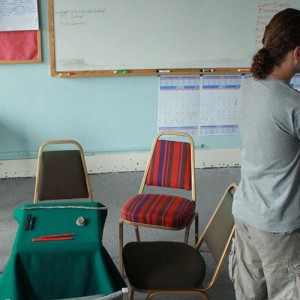1 hr, 1 minute and 46 seconds.
In this episode, Evan interviews Peter and Pulikli, two Chinuk Wawa WAYK game leaders. Listen in on how WAYK “curriculum” design works, by joining this discussion about how WAYK players designed the Chinuk Wawa “family” conversation.
1. Technique “Set-up“
- Peter describes the “set-up” – rigorously using technique “limit“, for the first round.
- The second time, they worked on correcting our language use, with Evan’s help.
- The conversation went quite well when played later with the rest of the Chinuk Night attendees, with about 8 players total.
2. Technique “Sing-a-long Song“
3. Technique “Slow/Fast“
- Thomas called for “slow“, since Peter was leading the game a bit too fast.
4. Technique “No-pressure Refresher“
- Peter says the group game started a bit rough, due to the time that passed since they last played.
5. Technique “What would you do differently next time?“
- They agree that they could improve the conversation by blowing up the photos of Thomas’, Peter’s and Pulikli’s families.
- Color seems very important when working with photographs.
6. Technique “One-on-one“
- Peter’s first “one-on-one” with a total newbie (Nikki) to Chinuk night.
- Our wall poster, showing a short list of techniques, helped him lead the game.
7. Technique “Set-up“
- Where did they sit? What table surface did they use? How did they respond to the games around them?
8. Technique “Angel on your Shoulder“
- Peter didn’t realize he had the option to call in a “lunatic fringe” to help.
9. Technique “Lunatic Fringe“
- Pulikli explains how he learned to play, just by watching from the “lunatic fringe“.
- “The game is so simple…it’s like reading a Dr. Seuss book…”
10. Technique “Full“
- Peter watches Nikki, his newbie player, take really good care of herself by calling “full” early and often. This allows her to keep coming back, and keep playing.
11. Technique “How Fascinating!“
- Peter focused on “modeling” lots of “How Fascinating!” for her.
12. Technique “Language Hunting“
- Peter talks about how he has begun working his hunting skills, and what it’s like to hunt another “language hunter“, in his “rent” conversation with Evan.
- Evan hunts Peter for what he knows, and doesn’t know, as he in turn senses what Peter wants to hunt from him.
13. Technique “Push/Pull“
- The rhythm that emerges between two “language hunters“, a relatively effortless back and forth conversation, discovering new words and language structure along the way.
14. Technique “Bridge Language“
- Sign language helped Evan read Peter’s mind in the context of Peter’s “what I did in Molalla over the weekend” conversation.
15. Technique “Shared Experience” vs. “Same Conversation”
- The difference between these two techniques.
- Each technique added, one by one, accelerates language acquisition – each technique describes a very specific, contextual accelerator.
15. Technique “Bob and Ray“
- Pulikli coins a new technique – guessing the word a “language hunter” wants from you, as soon as you can fill it in.
16. Technique “Memory Room“
- Using physical objects to tell stories, as inspired by Martín Prechtel.
- Applying techniques “TPR” and “Obviously!” to the Jesuit/ancient Greek Palace memory system.
17. Technique “the Walk“
- Pulikli commits to leading the next “Walk“.





